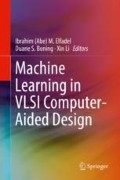Abstract
Advanced logic and physical synthesis tools provide numerous options and parameters that can drastically impact design quality; however, the large number of options leads to a complex design space difficult for human designers to navigate. By employing intelligent search strategies and parallel computing we can tackle this parameter tuning problem, thus automating one of the key design tasks conventionally performed by a human designer. To fully utilize the optimization potential of these tools, we propose SynTunSys, a system that adds a new level of abstraction between designers and design tools for managing the design space exploration process. SynTunSys takes control of the synthesis parameter tuning process, i.e., job submission, results analysis, and next-step decision making, automating one of the more difficult decision processes faced by designers. This system has been employed for optimizing multiple IBM high-performance server chips and presents numerous opportunities for future intelligent automation research.
Access this chapter
Tax calculation will be finalised at checkout
Purchases are for personal use only
Notes
- 1.
A macro, also referred to as a partition, is a separately synthesized component that is integrated into a larger chip. Macros considered in this chapter may span in size from 1K to 1M gates.
- 2.
The typical timing metrics of interest are: (1) internal slack or latch-to-latch slack (L2L), (2) worst negative slack (WNS), and (3) total negative slack (TNS).
- 3.
The server chips described in this chapter often go through two chip releases, a.k.a. tapeouts. The first tapeout is less optimized early version of the chip, whereas the second tapeout targets an optimized production quality chip.
- 4.
While many more configurations are possible, this experiment illustrates our initial attempt to configure the Learning algorithm parameters. Over time we have performed additional configuration experiments and designers running SynTunSys can also reconfigure the Learning algorithm as needed via the Rules file.
References
J.D. Warnock et al., 22nm next-generation IBM system z microprocessor, in ISSCC, 2015
M.M. Ziegler et al., A synthesis-parameter tuning system for autonomous design-space exploration, in DATE, 2016
M.M. Ziegler, H.-Y. Liu, L.P. Carloni, Scalable auto-tuning of synthesis parameters for optimizing high-performance processors, in ISLPED, 2016
M.M. Ziegler et al., POWER8 design methodology innovations for improving productivity and reducing power, in CICC, 2014
L. Trevillyan et al., An integrated environment for technology closure of deep-submicron IC designs. IEEE Des. Test Comput. 21(1), 14–22 (2004)
M.M. Ziegler, G.D. Gristede, V.V. Zyuban, Power reduction by aggressive synthesis design space exploration, in ISLPED, 2013
E.J. Fluhr et al., POWER8: a 12-core server-class processor in 22nm SOI with 7.6Tb/s off-chip bandwidth, in ISSCC, 2014
C. Gonzalez et al., POWER9: a processor family optimized for cognitive computing with 25Gb/s accelerator links and 16Gb/s PCIe Gen4, in ISSCC, 2017
C. Berry et al., IBM z14: 14nm microprocessor for the next-generation mainframe, in ISSCC, 2018
Y. Koren, R. Bell, C. Volinsky, Matrix factorization techniques for recommender systems. Computer 42, 30–37 (2009)
M. Anwar, S. Saha, M.M. Ziegler, L. Reddy, Early scenario pruning for efficient design space exploration in physical synthesis, in International Conference on VLSI Design (VLSID), 2016
S. Zhou et al., Utopia: A Load Sharing Facility for Large, Heterogeneous Distributed Computer Systems (Wiley, New York, 1993)
G.P. Mariani et al., DeSpErate++: an enhanced design space exploration framework using predictive simulation scheduling. IEEE Trans. Comput. Aided Des. Integr. Circuits Syst. 34(2), 293–306 (2015)
S. Amaran et al., Simulation optimization: a review of algorithms and applications. 4OR: Q. J. Oper. Res. 12, 301–333 (2014)
G. Fursin et al., Milepost GCC: machine learning enabled self-tuning compiler. Int. J. Parallel Prog. 39, 296–327 (2011)
A. Arcuri, G. Fraser, Parameter tuning or default values? An empirical investigation in search-based software engineering. Empir. Softw. Eng. 18(3), 594–623 (2013)
H.H. Hoos, Programming by optimization. Commun. ACM 55(2), 70–80 (2012)
G.I. Diaz, A. Fokoue-Nkoutche, G. Nannicini, H. Samulowitz, An effective algorithm for hyperparameter optimization of neural networks. IBM J. Res. Dev. 61(4), 9:1–9:11 (2017)
O. Azizi et al., An integrated framework for joint design space exploration of microarchitecture and circuits, in DATE, 2010
H.-Y. Liu, L.P. Carloni, On learning-based methods for design-space exploration with high-level synthesis, in DAC, 2013
M.K. Papamichael, P. Milder, J.C. Hoe, Nautilus: fast automated IP design space search using guided genetic algorithms, in DAC, 2015
N. Kapre et al., Driving timing convergence of FPGA designs through machine learning and cloud computing, in FCCM, 2015
C. Xu et al., A parallel bandit-based approach for autotuning FPGA compilation, in FPGA, 2017
Author information
Authors and Affiliations
Corresponding author
Editor information
Editors and Affiliations
Rights and permissions
Copyright information
© 2019 Springer Nature Switzerland AG
About this chapter
Cite this chapter
Ziegler, M.M. et al. (2019). SynTunSys: A Synthesis Parameter Autotuning System for Optimizing High-Performance Processors. In: Elfadel, I., Boning, D., Li, X. (eds) Machine Learning in VLSI Computer-Aided Design. Springer, Cham. https://doi.org/10.1007/978-3-030-04666-8_18
Download citation
DOI: https://doi.org/10.1007/978-3-030-04666-8_18
Published:
Publisher Name: Springer, Cham
Print ISBN: 978-3-030-04665-1
Online ISBN: 978-3-030-04666-8
eBook Packages: EngineeringEngineering (R0)

